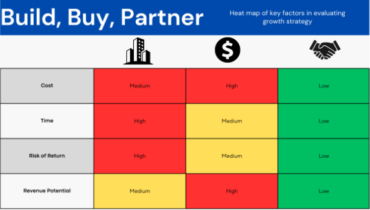
When evaluating a new offering or market organizations may evaluate whether the most effective approach is to build, buy, or partner. Given current interest rates and somewhat more hesitant capital investment, this can make acquisitions or organic build-out more difficult. However, even in the rosiest of financial climates, partnering offers a lower risk, high net return, in terms of both time and cost.
Let’s break down four pillars of the build, buy, partner dynamic:
1. Cost – the dollars invested to bring a new offering to market
2. Time – the duration from ideation until return is realized
3. Risk of return – the likelihood that the investment of cost and time is returned to the business making the investment
4. Revenue potential – how much of the offering can you reasonably expect to sell
Build
Creating a new product is something companies do. If you have a product and see an opportunity for a complementary solution, the first inclination is often to build that product in house. It makes sense. You control the feedback loop, design, go to market, revenue, etc. It’s your product. Yet, thinking about it, building a product can be costly and time consuming and there’s a risk you’re going to butt heads with other entrants already in the market. While the upside for revenue exists, it can be a lengthy journey.
You may need to delay or re-prioritize other projects to assign resources to tackle this new offering. Looking for additional funding could be an option to help add resources now to not lose momentum on existing offerings. Those things both take time and effort that may or may not see a real return. If you seek outside investment, that means providing a return. If you opt to use existing dollars, it can hurt margins or delay other items requiring cash. So, while it may seem logical at first glance, the hurdles may give you pause and look at other options.
Buy
Mergers and acquisitions are a big part of the landscape, particularly in tech. Companies that are looking to penetrate new verticals, add new offerings, or tackle new geographies may look to M&A to help accomplish those goals more quickly than organic development and growth. While this may shorten the time to market relative to internal development, it does come at a higher cost, as you’re paying a multiple of revenue. You will get a bump in revenue on closing the deal, but if you’ve sunk 10x (or more) in a multiple to buy, it will take several years to recoup the initial investment. Plus, you have the challenge of integrating technology, and more important, corporate cultures. The risk of return is somewhat lower than organic growth, as you’re hopefully acquiring an organization that has revenue and potentially profit. You also have better visibility by reviewing financials to make projections about future revenue that will be clearer than those made when starting from scratch.
Partner
What if we propose an approach that limits risk, accelerates time to market, and incurs a far lower cost than building or acquiring a solution? What if that option also allows for the potential to entertain an M&A event, or deep financial relationship like a joint venture?
Creating a partnership might just be the most impactful way to test a new market, work with another vendor that is getting it done today and lower your overall risk. Yes, some will point out that revenue potential is lower than an acquisition or organic growth, but a well-designed and executed partnership will increase revenue for you and your partner, all while delivering greater value for your customers, which is a strong indicator of additional growth.
Partnerships can be executed more rapidly than either development or acquisition, can have terms outlined that provides exit clauses for both sides, and has much lower startup costs as you’re drawing fractional time from multiple teams in both organizations. Yes, there is a cost, but it’s distributed and creates less drag than investment or spending cash reserves.
While this is by no means a silver bullet, when evaluating the options of cost, time, risk, and revenue, partnerships offer a strong mix of revenue potential at lower risk with faster time to value. As executives and strategy teams look at strong ways to grow a brand and increase revenue, placing greater emphasis on partnerships can be a strong win for employees, customers, and investors alike. Ensuring that you have this option on the table for every strategic decision can rapidly accelerate market penetration and growth for companies attempting to make a broader and deeper impact in their space.






